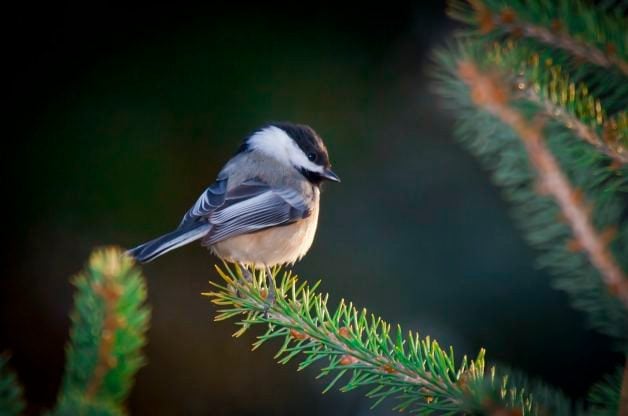Small Trees That Attract Birds for Food, Shelter and Nesting
Updated: Nov. 18, 2020

Attract more birds with these small trees and shrubs that provide food and shelter in all seasons. These varieties are perfect for small landscapes.
When it comes to attracting birds, there is a guaranteed recipe for success. Birds are attracted to a backyard that provides the tempting trio of food, shelter and nesting sites. And what’s a great way to offer all three? Conifers!
Seed-filled or berrylike cones offer food for birds like crossbills, while dense branches provide four-season refuge as a place to nest or hide from predators. Problem is, if your yard doesn’t already boast a few conifers, you may not have the space to grow a full-sized fir or large Colorado blue spruce.
That’s where dwarf conifers come in. These compact versions of the large trees offer beauty, versatility and the qualities that attract birds.
With sizes ranging from low-growing ground covers to small globe shapes to pyramidal trees growing 5 feet tall, small trees and shrubs easily fit into yards of all sizes. And, in addition to making your place more bird-friendly, their small stature and interesting colors and needle textures satisfy a broad range of landscape needs.
Small Trees That Attract Birds
While these small, or dwarf, trees are slower growing and smaller in stature than their full-size counterparts, the rate of growth and the ultimate height depend on your climate, site conditions and characteristics of the particular species.
Dwarf conifers offer a wide range of colors, shapes and textures, making them a great choice for scaled-down landscapes. Color options go beyond your typical shades of green to include yellows and oranges, soothing tones of blue, or variegated needles or scales.
Certain conifers even change color with the season—whether as contrasting shades of new spring growth, the fall foliage of deciduous conifers like larch, or the interesting plum color that appears with cooler weather on trees like false cypress and many juniper ground covers. Showy cone-like flowers on certain species of fir, spruce and pine provide spring color in hues of pink, purple, lavender and red.
The more diminutive varieties don’t provide much shelter for birds, though these ground covers can complement other plants or provide cones for feeding birds. The key is to select trees that serve birds, yet still fit the size and style of your landscape.
For shelter and nesting purposes, select trees with an upright or drooping growth habit. If you’re unsure how they’ll grow, check the plant information. There also may be clues in the tree’s botanical name. Upright cultivars often contain the words Fastigiata or Columnaris, while Pendular means it has drooping branches.
Small Evergreens for Feeding Birds
Small evergreen shrubs that grow in attractive mounds or are shaped like pyramids make great structural accents. Two examples are dwarf western hemlock (Tsuga heterophylla ‘Thorsen’s Weeping’) and dwarf Sawara false cypress (Chamaecyparis pisifera ‘Curly Tops’). Dwarf columnar species, such as common juniper (Juniperus communis ‘Compressa’) or eastern arborvitae (Thuja occidentalis ‘Degrott’s Spire’), provide intriguing exclamation points of interest in perennial beds or borders.
The selection of conifers for feeding birds is quite broad. The seed-filled cones of spruces, firs, pines and many others appeal to nuthatches, finches, grosbeaks, chickadees and other seed-eating birds. Junipers and yews provide a feast of berrylike cones for species like waxwings, robins, bluebirds and sparrows.
When and Where to Plant Trees
The best time to plant conifers is during the cool days of fall or anytime the ground is not frozen. Areas with milder climates can plant anytime from October through March. Most conifers grow best in slightly acidic soil in a sunny, well-drained site. Give the trees a bit of afternoon shade in the hot, southern regions of the country.
For the most part, yews (Taxus), hemlocks (Tsuga) and some species of false cypress (Chamaecyparis) also do well in partial shade. However, there are certain cultivars in nearly all conifer types that will tolerate some shade.
As a general rule, conifers also prefer moderately moist soil, though junipers, pines and true cedars (Cedrus) easily adapt to dry conditions once they are established.
Once planted, the trees don’t require much care. Soils of average or less fertility actually help encourage the dwarf characteristics, so applying a thin layer of organic mulch, such as compost, pine needles, shredded bark or leaves, once a year is plenty.
Love evergreens? Check out the types of Christmas trees you can grow.
Seven Best Small Trees with Benefits for Birds
These small trees may be dwarf in size, but they all provide giant benefits to birds in the way of seeded cones, insects and year-round shelter.
Creeping juniper
(Juniperus horizontalis ‘Mother Lode’)
Attractive ground cover with bright, golden-yellow foliage that turns plum in winter. Berrylike cones. Zones 3 to 9.
Dwarf Canadian hemlock
(Tsuga canadensis ‘Cole’s Prostrate’)
Low, spreading habit with cascading branches. Dense shelter for ground-feeding birds like towhees and juncos. Zones 4 to 8.
Dwarf Colorado spruce
(Picea pungens ‘Montgomery’)
Intensely blue, dense mound that becomes pyramidal to 5 feet tall when mature. Favored by chickadees and grosbeaks. Zones 3 to 8.
Dwarf mugo pine
(Pinus mugo ‘Slowmound’)
Dense, dark-green foliage, grows 3 to 5 feet tall and wide in 10 years. Zones 2 to 7.
Dwarf Korean fir
(Abies koreana ‘Starker’s Dwarf’)
Dwarf nest-form tree, grows 3 to 4 feet tall. Zones 4 to 6.
Golden eastern arborvitae
(Thuja occidentalis ‘Rheingold’)
Orangish-gold, globe-shaped tree with soft young foliage. Grows to 4 feet in 10 years. Zones 4 to 7.
Sawara false cypress
(Chamaecyparis pisifera ‘Curly Tops’)
Silvery-blue foliage with distinctive curled needles. Pyramidal habit, grows 5 to 8 feet tall. Zones 4 to 8.
